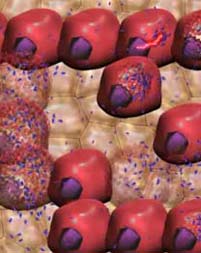Product Strengths
The concept of using targeted oncolytic viruses for cancer has been around for several decades. Tremendous progress in our understanding of cancer and viruses, combined with breakthroughs in DNA engineering, has enabled Jennerex to engineer our oncolytic virus therapies to achieve maximum safety and efficacy. Jennerex experts have more combined years of experience than any other team in the field. Targeted oncolytic poxviruses for cancer hold significant commercial and medical potential and represent a breakthrough technology for cancer. The primary reasons are their enhanced tolerability and efficacy versus currently available treatments such as chemotherapy. First, these products are highly selective for cancer and therefore have minimal side effects (flu-like symptoms). In addition, their efficacy is driven by three, novel mechanisms of action: 1) the lysis of cancer cells through viral replication, 2) the reduction of the blood supply to tumors through vascular targeting and destruction, and 3) the stimulation of the body's immune response against cancer cells. Of note, these mechanisms are non-cross resistant with other approved available therapies. Therefore, these products have the potential to treat tumors that have failed all other available therapies. In addition, given their novel mechanisms of action, these products can also be combined with other complementary therapies in order to get patients the best aspects of each product.
Despite clear safety and localized efficacy in clinical trials with oncolytic viruses, the major hurdle that had not previously been overcome was the ability to deliver these products intravenously in order to achieve systemic efficacy. In June 2010, we presented clinical data proving the ability of JX-594 to be delivered intravenously to tumors effectively and safely. This hurdle has therefore been overcome; we see this historic achievement as a significant milestone for this product class.
We have presented data from multiple clinical trials that have shown anticancer activity across several types of cancer, a trend toward a dose-dependent survival benefit and a consistently strong tolerability profile. The next step for this program will be to demonstrate in a large randomized trial that JX-594 in fact increases survival in patients. With that goal in mind, we expect to initiate a large, randomized late-stage clinical trial in 2011 in patients with advanced liver cancer.

